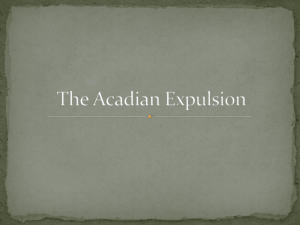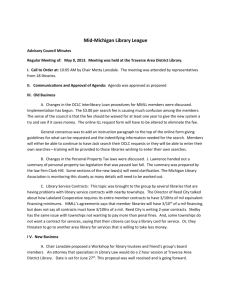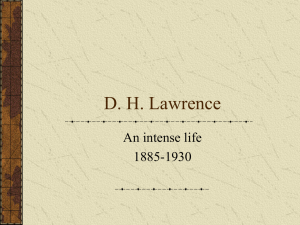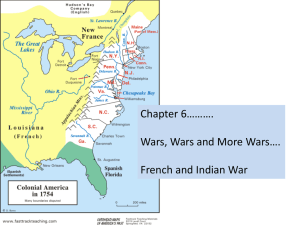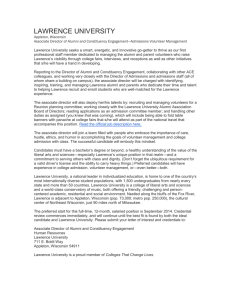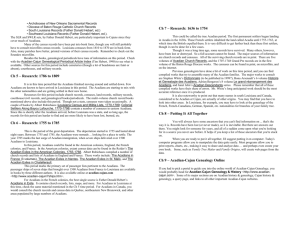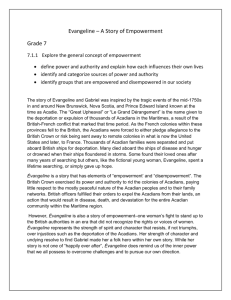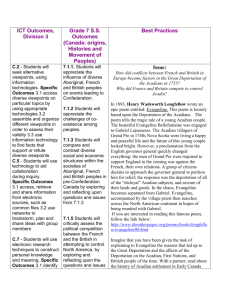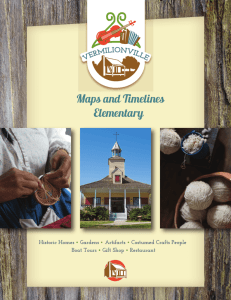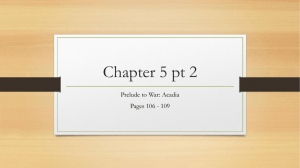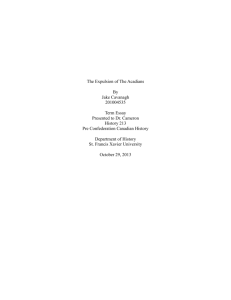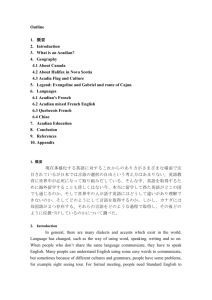2010 12 October
advertisement
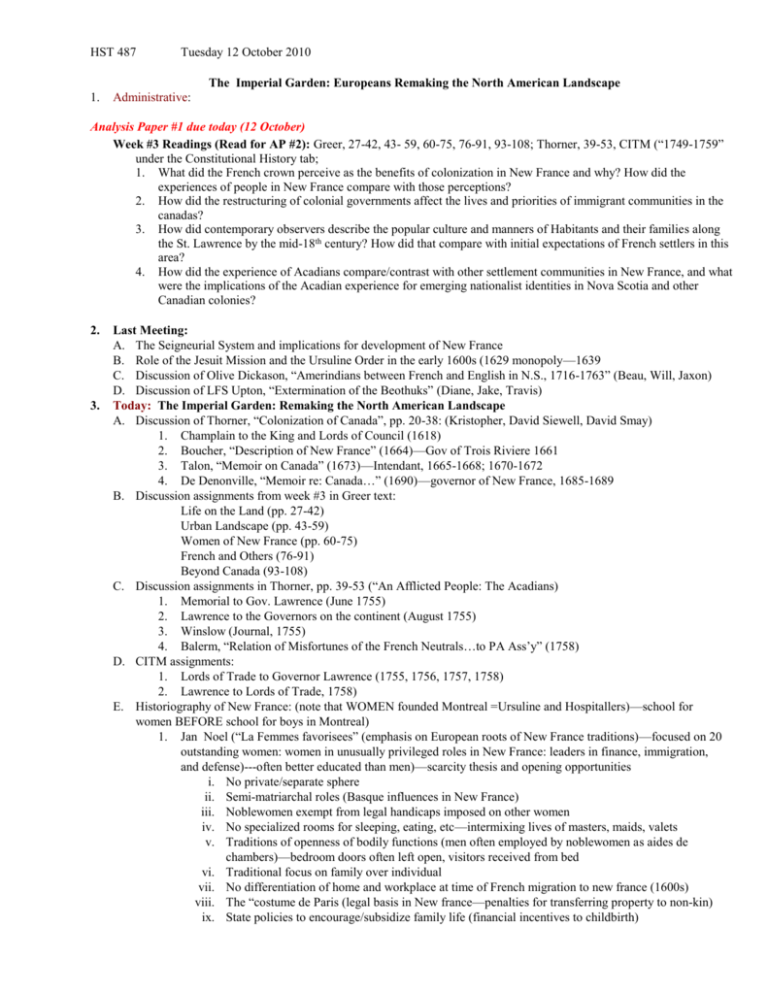
HST 487 Tuesday 12 October 2010 The Imperial Garden: Europeans Remaking the North American Landscape 1. Administrative: Analysis Paper #1 due today (12 October) Week #3 Readings (Read for AP #2): Greer, 27-42, 43- 59, 60-75, 76-91, 93-108; Thorner, 39-53, CITM (“1749-1759” under the Constitutional History tab; 1. What did the French crown perceive as the benefits of colonization in New France and why? How did the experiences of people in New France compare with those perceptions? 2. How did the restructuring of colonial governments affect the lives and priorities of immigrant communities in the canadas? 3. How did contemporary observers describe the popular culture and manners of Habitants and their families along the St. Lawrence by the mid-18th century? How did that compare with initial expectations of French settlers in this area? 4. How did the experience of Acadians compare/contrast with other settlement communities in New France, and what were the implications of the Acadian experience for emerging nationalist identities in Nova Scotia and other Canadian colonies? 2. 3. Last Meeting: A. The Seigneurial System and implications for development of New France B. Role of the Jesuit Mission and the Ursuline Order in the early 1600s (1629 monopoly—1639 C. Discussion of Olive Dickason, “Amerindians between French and English in N.S., 1716-1763” (Beau, Will, Jaxon) D. Discussion of LFS Upton, “Extermination of the Beothuks” (Diane, Jake, Travis) Today: The Imperial Garden: Remaking the North American Landscape A. Discussion of Thorner, “Colonization of Canada”, pp. 20-38: (Kristopher, David Siewell, David Smay) 1. Champlain to the King and Lords of Council (1618) 2. Boucher, “Description of New France” (1664)—Gov of Trois Riviere 1661 3. Talon, “Memoir on Canada” (1673)—Intendant, 1665-1668; 1670-1672 4. De Denonville, “Memoir re: Canada…” (1690)—governor of New France, 1685-1689 B. Discussion assignments from week #3 in Greer text: Life on the Land (pp. 27-42) Urban Landscape (pp. 43-59) Women of New France (pp. 60-75) French and Others (76-91) Beyond Canada (93-108) C. Discussion assignments in Thorner, pp. 39-53 (“An Afflicted People: The Acadians) 1. Memorial to Gov. Lawrence (June 1755) 2. Lawrence to the Governors on the continent (August 1755) 3. Winslow (Journal, 1755) 4. Balerm, “Relation of Misfortunes of the French Neutrals…to PA Ass’y” (1758) D. CITM assignments: 1. Lords of Trade to Governor Lawrence (1755, 1756, 1757, 1758) 2. Lawrence to Lords of Trade, 1758) E. Historiography of New France: (note that WOMEN founded Montreal =Ursuline and Hospitallers)—school for women BEFORE school for boys in Montreal) 1. Jan Noel (“La Femmes favorisees” (emphasis on European roots of New France traditions)—focused on 20 outstanding women: women in unusually privileged roles in New France: leaders in finance, immigration, and defense)---often better educated than men)—scarcity thesis and opening opportunities i. No private/separate sphere ii. Semi-matriarchal roles (Basque influences in New France) iii. Noblewomen exempt from legal handicaps imposed on other women iv. No specialized rooms for sleeping, eating, etc—intermixing lives of masters, maids, valets v. Traditions of openness of bodily functions (men often employed by noblewomen as aides de chambers)—bedroom doors often left open, visitors received from bed vi. Traditional focus on family over individual vii. No differentiation of home and workplace at time of French migration to new france (1600s) viii. The “costume de Paris (legal basis in New france—penalties for transferring property to non-kin) ix. State policies to encourage/subsidize family life (financial incentives to childbirth) 2. 3. 4. 5. 6. 4. Eccles, W.J., “Frontier and Society”/”the Ordeal of New France”—landscape and new france as origins of unique role of women: i. New France as the “Sparta” of North America, New England the “Athens” ii. Emphasis on martial spirit of Canadiens & impact of living close to Indians (young men, among “savages” and escape from parents) iii. Ethic of ostentatious living rather than storing up material goods (vs. Puritan ethic) iv. Canadiens as a travelling, continental people v. Relatively tax free, open land vi. “luxuries” of iced drinks, plentiful fish and game, more varied, nutritious diet vii. Reluctance to work hard viii. Disrespectful to social superiors/lawless frontier, disrespect to clergy (but not overt “resistance” to authority—passive-aggressive demeanors ix. Aristocratic and military ethos of leadership in New France Dale Miquelon, “New France” Louise Dechene, “Habitants and Merchants in New France” R. Colebrook Harris, “The Seigneurial System in New France” Naomi Griffiths, “The Golden Age: Acadia, 1713-1748”—“neutrality” thesis and era of multiethnicity/demographic growth—pop doubled every 20 years with NO IMMIGRATION: i. Women who married before age 20 AVERAGED 11 children!! ii. Women who married between 20 and 24 AVERAGED 8 children iii. Virtually disease free, long life expectancy relative to virtually anywhere else iv. Village-level alliances vs imperial loyalties!!!! Eccles, “pre-emptive conquest” (1972—writing in era of radical Quebec nationalism/separatism) 7. Terms: Jean Talon (Intendant, 1665Pierre Le Moyne d’Iberville (1661-1706) Charles Lawrence (Governor of N.S.) The Acadians Coutoume de Paris (legal standard Port Royal/Annapolis Royal (1710-1713) The Acadian dilemma (1713-1758) York Factory (ca. 1670-1713) War of Austrian Succession (1740-1748) Siege of Louisbourg (Spring 1745) Sovereign Council (Gov, Int., Bishop & councilors) The Royal Takeover (1663) The Lords of Trade the Desaulniers Sisters (Khanawagha trading post) Shanawdithit (Beothuk, ca. 1800-1830) Treaty of Utrecht (1713) The Marquis de Vaudreuil (governor, 1755-1757) Governor of Acadian Affairs (Louisbourg, 1717-1760 Treaty of Aix-la-Chappelle (1748) Halifax (est. 1749)
